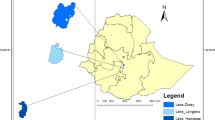Abstract
Bacteria flora of intestine and hepatopancreas, body surface and muscles of juvenilePenaeus monodon along with its rearing water and sediment was analyzed. Juvenile shrimp were reared in four tanks in the Hatchery complex, Department of Aquaculture, Faculty of Agriculture, University Putra Malaysia. Water quality parameters were measured every day. Samples were collected aseptically and homogenized before being inoculated in Tryptone Soy agar, Thiosulphate Citrate Bile Salt agar, MacConkey agar andPseudomonas-isolating agar. There was no significant difference between water quality parameters and shrimp body weight of replicate tanks. Total plate count for water and totalVibrio count for rearing water and digestive system were within previous reported ranges. Eight different genera were isolated in which 7 genera were identified. Gram negative bacteria were dominant (72%)Vibrio was the most dominant genera followed byShewanella andBurkholderia. Clavibacter followed byStaphylococcus were the most dominant gram positive bacteria. No coliform bacteria was detected in the shrimp body parts and rearing environment. Incidence ofShewanella in the digestive system was significantly higher than sediment, rearing water and muscles. This may be implied its ability to colonize in the digestive tract of juvenileP. monodon.
Similar content being viewed by others
References
Anderson I.G., Nor Shamsudin M., Nash G. (1989). A preliminary study on the aerobic heterotrophic bacterial flora in giant fresh water prawn,Macrobrachium rosenbergii, hatcheries in Malaysia. Aquaculture, 81: 213–223.
Bhaskar N., Rudra Setty T.M., Vidya Sagar Reddy G., Manoj Y.B., Anantha C.S., Raghunath B.S., Antony J.M. (1995). Incidence ofSalmonella in cultured shrimpPenaeus monodon. Aquaculture, 138: 257–266.
Brisou J., Tysset C., de la Roy Y.R., Curcier R. (1965). Marine bacteria especially Micrococcaceae. J. Gen. Microbiol., 41 (1): 23–41.
Buchanan R.E. (1984). Bergey’s Manual of Determinative Bacteriology, Williams and Wilkins Co., Baltimore.
Chahill M.M. (1990). Bacterial flora of fishes: A review. Microb. Ecol., 19: 21–41.
Colorni A. (1985). A study on the bacterial flora of giant prawn,Macrobrachium rosenbergii, larvae fed withArtemia salina nauplii. Aquaculture, 49: 1–10.
Costa R., Mermoud I., Koblavi S., Morlet B., Haffner P., Berthe F., Legroumellec M. Grimont P. (1998). Isolation and characterization of bacteria associated with aPenaeus stylirostris disease (Syndrome 93) in New Caledonia. Aquaculture, 164: 297–309.
Dilmore L.A. (1986). Vibrios of some deep-water invertebrates. FEMS Microbiol. Lett., 35: 221–224.
Drew W.L., Edelstein M.A.C., Garcia L.S., Roberts G.D. (1986). Bailey and Scott’s Diagnostic Microbiology, C. V. Mosby Co., ST. Louis.
Hameed S. (1993). A study of the aerobic heterotrophic bacterial flora of hatery-reared eggs, larvae and post-larvaeofPenaeus indicus. Aquaculture, 117: 195–204.
Kennedy B., Venugopal M.N., Karunasagar I., Karunasagar I. (2006). Bacterial flora associated with the giant freshwater prawnMacrobrachium rosenbergii, in the hatchery system. Aquaculture, 261: 1156–1167.
Leaño E.M., Lavilla-Pitogo C.R., Paner M.G. (1998). Bacterial flora in the hepatopancreas of pond-rearedPenaeus monodon juveniles with luminous vibriosis. Aquaculture, 164: 367–374.
Li C.C., Yeh S.T., Chen J.C. (2008). The immune respose of white shrimpLitopenaeus vannamei followingVibrio alginolyticus injection. Fish Shellfish Immun., 25 (6): 850–860.
Lightner D.V. (1996). A handbook of shrimp pathology and diagnostic procedures for diseases of cultured penaeid shrimp. World Aquaculture Society, Baton Rouge, LA, USA.
MacFaddin J.F. (1980). Biochemical Tests for Identification of Medical Bacteria, Williams and Wilkins, Baltimore.
Moriarty D.J.W. (1998). Control of luminousVibrio species in penaeid aquaculture pond. Aquaculture, 164: 351–358.
Muroga K., Higashi M., Keitoku H. (1987). The isolation of intestinal microflora of farmed red sea bream (Pagrus major) and black sea bream (Acanthopagrus schlegeli) at larval and juvenile stages. Aquaculture, 65: 79–88.
Olsson C., Ahrne S., Pettersson B., Molin G. (2004). DNA based classification of food associated Enterobacteriaceae previously identified by biolog GN Microplates. Syst. Appl. Microbiol., 27: 219–228.
Otta S.K., Karunasagar I., Karunasagar I. (2001). Bacteriological study of shrimp,Penaeus monodon Fabricius, hatcheries in India. J. Appl. Ichthyol., 17: 59–63.
Phatarpekar P.V., Kenkre V.D., Sreepada R.A, Desai U.M., Achuthankutty C.T. (2002). Bacterial flora associated with larval rearing of the giant freshwater prawn,Macrobrachium rosenbergii. Aquaculture, 203: 279–291.
Sung H., Hsu S., Chen C., Ting Y., Chao W. (2001). Relationships between disease outbreak in cultured tiger shrimp (Penaeus monodon) and the composition of Vibrio communities in pond water and shrimp hepatopancreas during cultivation. Aquaculture, 192: 101–110.
Sung H., Li H., Tsai F., Ting Y., Chaoa W. (1999). Changes in the composition of Vibrio communities in pond water during tiger shrimp (Penaeus monodon) cultivation and in the hepatopancreas of healthy and diseased shrimp. J. Exp. Mar. Biol. Ecol., 236: 261–271.
Vanderzant C., Nickelson R., Judkins P.W. (1971). Microbial flora of pond-reared brown shrimp (Penaeus aztecus). Appl. Microbiol., 21: 916–921.
Vaseeharan B.R.P. (2003). Abundance of potentially pathogenic micro-organisms inPenaeus monodon larvae rearing systems in India. Microbiol. Res., 158: 299–308.
Wang Y., Xu Z., Zhou X., Xia, M. (2005). Bacteria attached to suspended particles in Northern white shrimp (Penaeus vannamei L.) ponds. Aquaculture, 249: 285–290.
Yasuda K., Kiato T. (1980). Bacterial flora in the digestive tract of prawns,Penaeus japonicus bate. Aquaculture, 19: 229–234.
Author information
Authors and Affiliations
Corresponding author
Rights and permissions
About this article
Cite this article
Shakibazadeh, S., Saad, C.R., Christianus, A. et al. Bacteria flora associated with different body parts of hatchery reared juvenilePenaeus monodon, tanks water and sediment. Ann. Microbiol. 59, 425–430 (2009). https://doi.org/10.1007/BF03175126
Received:
Accepted:
Issue Date:
DOI: https://doi.org/10.1007/BF03175126



